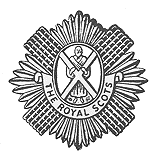Royal Regiment of Foot
| Royal Scots (The Royal Regiment) | |
|---|---|
 
Regimental Cap Badge and The Royal Cypher within the Collar of the Order of the Thistle with the badge appendant
|
|
| Active | 1633–2006 |
| Country |
|
| Branch |
|
| Type | Infantry |
| Role | Line infantry |
| Part of | Scottish Division |
| Garrison/HQ | Glencorse Barracks |
| Nickname(s) | Pontius Pilate's Bodyguard |
| Motto(s) |
Nemo me impune lacessit Latin: "Nobody harms me with impunity" |
| March |
Quick March: Dumbarton's Drums Slow March: Garb of Old Gaul |
| Engagements | See Battle honours list |
| Insignia | |
| Tactical recognition flash |  |
The Royal Scots (The Royal Regiment), once known as the Royal Regiment of Foot, was the oldest and most senior infantry regiment of the line of the British Army, having been raised in 1633 during the reign of Charles I of Scotland. The regiment existed continuously until 2006, when it amalgamated with the King's Own Scottish Borderers to become the Royal Scots Borderers, which merged with the Royal Highland Fusiliers (Princess Margaret's Own Glasgow and Ayrshire Regiment), the Black Watch, the Highlanders (Seaforth, Gordons and Camerons) and the Argyll and Sutherland Highlanders to form the Royal Regiment of Scotland.
The regiment was first raised in 1633 as the Royal Regiment of Foot by Sir John Hepburn, under a royal warrant from Charles I, on the Scottish establishment for service in France. It was formed from a nucleus of Hepburn's previous regiment, formerly in Swedish service, which had been in existence since 1625. When in France it absorbed the remnants of a number of other Scottish mercenary units which had fought in Swedish service, and by 1635 had swelled to some 8,000 men.Lord James Douglas was appointed the new colonel, and the name of the corps was altered to the Régiment de Douglas, numbering some 1200 Scotsmen. The regiment fought with distinction under Douglas until he was killed in a skirmish near Douai in 1645, in an attempt to take the city from the Habsburgs. His elder brother Archibald Douglas, Earl of Angus, was appointed in his place. In all the regiment served in France from 1633 to 1661, when it was recalled to England.
...
Wikipedia
